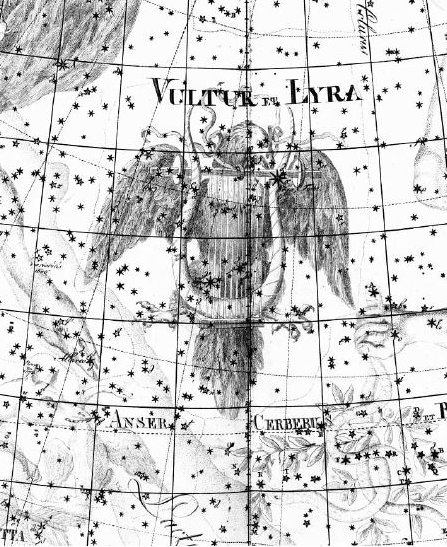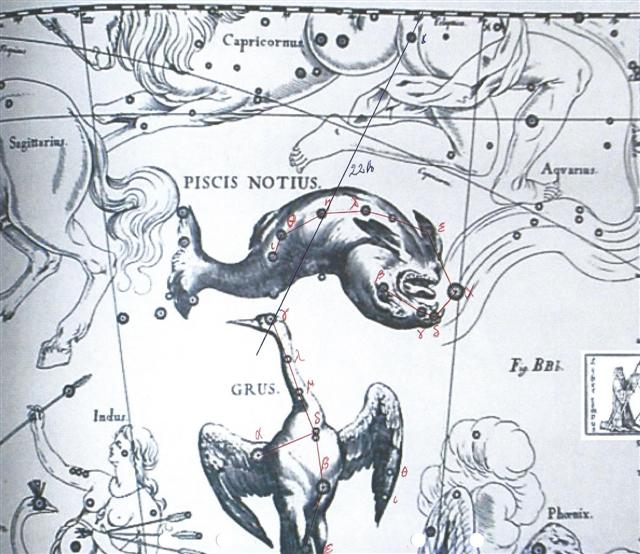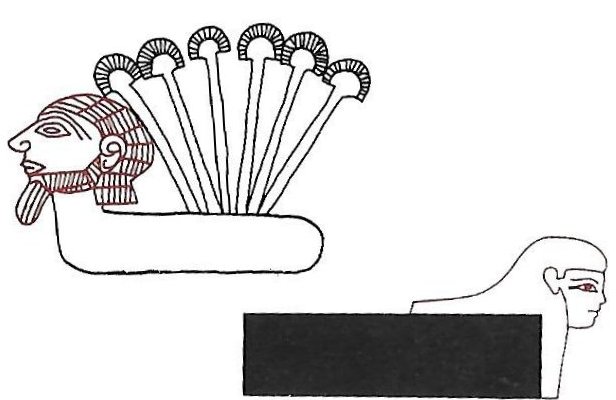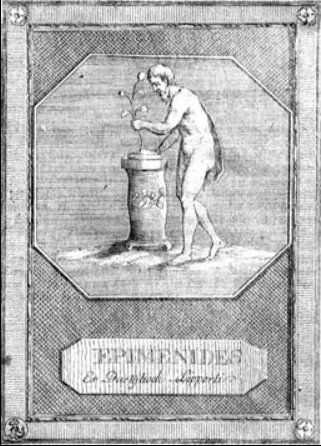488. The number of glyphs on side a
of the C tablet could also be explained as *392 =
*285 + *107, and then number 471 (glyphs on the G
tablet) could possibly be understood as 107 + 348 (= 12 * 29,
the number of glyphs on side b of the C tablet) + 16
(number of nights when a heliacal star was not yet
visible) = 107 + 364.
392 - 107 = 285 and 285 days from the
beginning of the C text - when Sirrah was at the Full
Moon in September 20 (263) - will bring us to glyph
number 285 corresponding to right ascendsion day *285 at the Full Moon,
viz. to July 1:
|
te ika |
te honu |
274 |
 |
 |
|
Ca1-7 |
Ca1-8 (= 740 - 2
* 366) |
|
CLOSE TO THE
FULL MOON: |
|
March 28
ANDROMEDA GALAXY
(M31),
π Andromedae
(7.7)
31 = 104 - (365
- 292) |
29 (88)
ε Andromedae
(8.2),
DELTA = δ
Andromedae
(8.4),
SCHEDIR (Breast)
= α Cassiopeiae
(8.6), ζ
Andromedae, μ
Phoenicis (8.9)
47.0 = 88.4 -
41.4 |
|
'March 1 (60) |
2 |
|
CLOSE TO THE
SUN: |
|
Sept 27 (270)
α Muscae
(190.2), τ
Centauri
(190.5), χ
Virginis (190.7)
ALDERAMIN (α
Cephei) |
28
Al Áwwā'-11 (The
Barker) /
Shur-mahrū-shirū-18
(Front or West
Shur)
SOMBRERO GALAXY
= M104 Virginis
(191.1),
ρ
Virginis
(191.4),
PORRIMA =
γ
Virginis,
γ
Centauri (191.5)
*150.0 = *191.4
- *41.4
104 = 31 + (365
- 292) |
|
'Aug 31 |
'Sept 1 (244) |
|
te
inoino |
te
tagata |
E
inoino |
te
inoino |
kua
haga |
 |
 |
 |
 |
 |
|
Ca10-28 (8 + 275) |
Ca10-29 (284) |
Ca11-1 |
Ca11-2 |
Ca11-3 (246 + 41) |
|
CLOSE TO THE FULL MOON: |
|
Dec 29
ζ
Pavonis (283.4),
λ
Cor. Austr. (283.6),
DOUBLE DOUBLE =
ε
Lyrae
(283.7),
ζ
Lyrae (283.8)
*242.0 = *283.4 - *41.4 |
30 (364)
South Dipper-8 (Unicorn)
Φ Sagittarii
(284.0),
μ
Cor. Austr. (284.6),
η
Cor. Austr.,
θ
Pavonis (284.8) |
31
SHELIAK
(Tortoise) =
β
Lyrae,
ν
Lyrae (285.1),
ο
Draconis (285.5).
λ
Pavonis (285.7)
ATLAS (27 Tauri) |
Jan 1
χ
Oct. (286.0),
AIN AL RAMI (Eye of the
Archeer) =
ν
Sagittarii
(286.2),
υ
Draconis (286.4),
δ
Lyrae (286.3),
κ
Pavonis (286.5),
ALYA (Fat Tail) =
θ
Serpentis
(286.6)
*245.0 = *286.4 - *41.4 |
2
ξ
Sagittarii (287.1),
ω
Pavonis (287.3),
ε
Aquilae,
ε
Cor. Austr.,
SULAPHAT (Little
Tortoise Shell) =
γ
Lyrae
(287.4),
λ
Lyrae (287.7),
ASCELLA
(Armpit) =
ζ
Sagittarii,
BERED = i Aquilae (Ant.)
(287.9)
*246.0 = *287.4 - *41.4 |
|
'Dec 2 (336 = 4 * 84) |
3 |
4 |
5 |
6 |
 |
|
CLOSE TO THE SUN: |
|
June 29 (180)
ψ4 Aurigae (100.5),
MEBSUTA (Outstretched)
= ε Gemini
(100.7) |
30
SIRIUS = α Canis Majoris
(101.2), ψ5 Aurigae
(101.4), ν Gemini
(101.6), ψ6 Aurigae
(101.7)
*60.0 = *101.4 - *41.4 |
July 1
τ Puppis (102.2), ψ7
Aurigae (102.4)
*61.0 = *102.4 - *41.4 |
2
Mash-mashu-sha-Risū-9
(Twins of the Shepherd)
θ Gemini (103.0), ψ8
Aurigae (103.2),
ALHENA =
γ Gemini
(103.8), ψ9 Aurigae
(103.9)
|
3 (183)
ADARA (Virgins) = ε
Canis Majoris
(104.8) |
|
... Al Maisān,
the title of
γ
Geminorum [Alhena], by
some error of Firuzabadi
was applied to this star
[Heka in Orion] as
Meissa, and is now
common for it. Al Sufi
called it Al Tahāyī;
but Al Ferghani and Al
Tizini knew it as Rās
al Jauzah, the Head
of the Jauzah, which it
marks. The original
Arabic name, Al
Hak'ah, a White
Spot, was from the added
faint light of the
smaller
φ¹and
φ²
in the background, and
has descended to us as
Heka and Hika.
These three stars were
another of the
Athāfiyy [tripods
used for cooking] of the
Arabs; and everywhere in
early astrology were
thought, like all
similar groups, to be of
unfortunate influence in
human affairs. They
constituted the
Euphratean lunar station
Mas-tab-ba-tur-tur,
the Little Twins, a
title also found for
γ
[Alhena] and
η
Geminorum [Tejat Prior];
and individually were
important stars among
the Babylonians, rising
to them with the sun at
the summer solstice,
and, with
α
and
γ,
were known as Kakkab
Sar, the
Constellation of the
King ... |
|
'June 2 |
3 |
4 |
5 |
6 (157 = 314 / 2) |
On Easter Island the end of June was
a dark season comparable to the end of December
north of the equator.
By the way, the Moon calendar was beginning at
*157 (= 314 / 2) and its 74 glyphs could have
indicated it was necessary to add 16 days - thereby
reaching 90 days (and 156 + 74 + 16 = 246 = 364 - 4
* 29½). In Roman times day 157 was where
the Sun rose together with the Virgins (Adara, ε
Canis Majoris).
...
Epimenides the Cretan - who said that all the
Cretans were liers - lived to be 157 years old, or
to be 299 or 154:
In contrast the number of glyphs
covering the contracted calendar for the year on
side a of the G tablet, viz. 123 (= 366 / 3 = 246 /
2), might have
indicated the addition 107 + 16 (implying 3 * 16 =
48 for a year).
And 16 could also have been used in
order to quickly deduce the date at the time of the
Bull. For instance was DECEMBER 31 (365) - 16 at
right ascension day *349 where the 'house' of the
Pegasus Square was beginning (viz. in March 4):
|
tagata ma te
kihikihi |
koia ra kua oho |
 |
 |
 |
|
Ca13-4 |
Ca13-5 (348) |
Ca13-6 |
|
CLOSE TO THE FULL
MOON: |
|
March 2 (61 = 31 +
28 + 2)
SCHEAT AQUARII = δ
Aquarii
(347.0),
ρ
Pegasi (347.2),
δ
Piscis Austrini
(347.4),
FOMALHAUT (Mouth of
the Fish) =
α
Piscis Austrini,
τ
Gruis (347.8)
*306 = *347.4 -
*41.4 |
3 (348 + 80 = 428)
FUM AL SAMAKAH
(Mouth of the Fish)
=
β
Piscium
(348.3),
ζ
Gruis (348.5),
ο
Andromedae (348.9) |
4 (365 + 64 = 429)
Al Fargh al
Mukdim-24 (Fore
Spout) /
Purva Bhādrapadā-26
(First of the
Blessed Feet) /
House-13 (Pig)
SCHEAT PEGASI =
β
Pegasi,
π
Piscis Austrini
(349.3),
κ
Gruis (349.4),
MARKAB PEGASI =
α
Pegasi
(349.5)
*308 = *349.4 -
*41.4 |
|
'Febr 4 (365 + 35 =
400) |
5 (36) |
6 |
|
DEC 29 |
30 (364 = 348 + 16) |
31 |
 |
|
CLOSE TO THE SUN: |
|
Sept 1 (12 * 12 +
100)
no star listed (164)
ALTAIR (α
Aquilae) |
2 (104 + 141)
Wings-27 (Snake)
η
Octans (165.4),
ALKES (Shallow
Basin) =
α
Crateris
(165.6)
*124 = *165.4 -
*41.4
|
3 (246)
ANA-TIPU-4
(Upper-side-pillar -
where the guards
stood)
MERAK (Loin) = β
Ursae Majoris
(166.2),
DUBHE (Bear) = α
Ursae Majoris
(166.7) |
When the Sun was
at α and
β Ursae Majoris
(Dubhe and Merak) then the
Full Moon was at
β and α
Pegasi (Scheat and Markab).
|
Egyptian head |
 |
Phoenician aleph |
 |
Greek alpha |
Α (α) |
|
In
Gardiner's sign list
this is E2,
aggressive bull. |
|
Egyptian
house |
 |
Phoenician
beth |
 |
Greek beta |
Β (β) |
|
... Like the
names of most
other Greek
letters, the
name of beta was
adopted from the
acrophonic name
of the
corresponding
letter in
Phoenician,
which was the
common Semitic
word *bayt
('house').
In the system of
Greek numerals
beta had
a value of 2.
... 'The
traditions show
that the
residences of
the king were
fairly flexible.
The building of
new houses was
obviously the
result of (male)
births in the
royal family. In
each case, the
house that was
built last is
left to the
newborn son and
his mother,
together with a
specific
servant, while
the king has a
new and separate
residence
constructed for
himself
...
 |
|









